Director’s foreword
Welcome again to another edition of the Department of Mines and Petroleum’s Environment eNewsletter.
It is now September, and the Environment Division is proceeding at a pace to implement the outstanding Reforming Environmental Regulations prior to the end of the year.
Since the last eNewsletter, we have had more successes – many of which are covered off in this edition. For instance, after a number of years of investing in online lodgment technologies, we were able to move to only receiving electronic versions of the principal environmental applications, namely:
- Mining Proposals
- Programmes of Work (exploration)
- Environment Plans
- Oil Spill Contingency Plans.
Thanks to the pre-planning, this occurred very smoothly, and was an important step on the way to moving towards electronic processing.
In addition, the second compulsory year for the Mining Rehabilitation Fund (MRF) has passed since the last eNewsletter. A great outcome of this was the improved level of compliance with reporting obligations compared to last year (which had in excess of 95% compliance).
I was also very pleased that the MRF has again achieved a category finalist status in the Annual Premier’s Awards (in the category of ‘Developing the Economy’). The Premier’s Awards are announced in November each year.
Dr Phil Gorey
Executive Director Environment
Golden Gecko Awards for 2015
Eight projects using innovative solutions and new technology to minimise environmental impacts on Western Australian resources projects have been announced as finalists for the 2015 Golden Gecko Awards.
The prestigious Golden Gecko Awards for Environmental Excellence is an annual award judged by a panel of industry experts and chaired by Department of Mines and Petroleum (DMP) Director General Richard Sellers.
The awards are based on four criteria: commitment to environmental excellence, demonstrated excellent environmental outcomes, community engagement and innovation.
The eight entrants and their projects eligible for the 2015 Golden Gecko Awards are:
- Kalgoorlie Consolidated Gold Mines
Gidji Emissions Reduction Project - Pilbara Mesquite Management Committee Inc
Battling the Thorny Menaces through Corporate Alliances - Fortescue Metals Group, Ziltek Pty Ltd and PT Environmental Services
Better Environmental Outcomes from Hydrocarbon Spills using RemScan™ - Premier Coal Limited and Golder Associates
Lake Kepwari Trial Flow-through - St Barbara Limited
Gwalia Operations Absorption Chiller Upgrade - Rio Tinto Iron Ore
Utilities Division West Angelas Fuel Hub - Pilbara Ports Authority
Mangrove Rehabilitation Program - Chevron Australia
Wheatstone Micro-tunnel Project
The Golden Gecko award ceremony and seminar will again be staged in two parts. The first part allows the finalists to give a short presentation to provide attendees and other nominees with a deeper understanding of the project. This presentation seminar is open to anyone interested in learning more about the finalists’ projects. The second part is a ticketed presentation ceremony and networking function open to anyone within the resources industry. Minister Marmion will present the 24th Annual Golden Gecko Award at Fraser Suites, East Perth on Thursday 29 October 2015.
Tickets for the ceremony are $50 and are limited. To purchase tickets you will firstly need to complete the registration form online, once registered you will then be able to pay online via the Stars Events website. Bookings close Friday 23 October 2015.
For more information, please contact Golden Gecko Co-ordinator Jessica Allen on (08) 9222 3102 or golden.gecko@dmp.wa.gov.au.
Abandoned Mines Policy 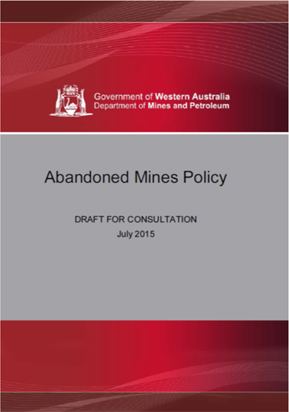
Stakeholder input was recently sought as part of the State Government’s development of a robust framework that supports the recording, prioritisation, management and rehabilitation of abandoned mine sites throughout Western Australia.
Department of Mines and Petroleum (DMP) Executive Director Environment Dr Phil Gorey said that broad stakeholder input was essential to the development of a policy that will deliver tangible benefits for the environment and local communities.
“The mining industry already has a strong interest in mine site rehabilitation through their annual contributions to the Mining Rehabilitation Fund (MRF),” Dr Gorey said
“Under the Mining Rehabilitation Fund Act 2012, funds can be used to rehabilitate future abandoned sites throughout the State, while interest generated on the fund can be used to rehabilitate legacy abandoned mine sites.”
While industry provides funding for rehabilitation, the focus is on delivering benefits at the local level.
“The State Government has a responsibility to ensure return on investment to the environment and local communities is maximised through delivery of an efficient abandoned mine site management and rehabilitation process,” Dr Gorey said.
“It is the local stakeholder groups who are directly impacted by the existence of these abandoned mine sites, so it is important that they have a say in how these sites should be managed and rehabilitated in order to achieve long term safety, environmental, economic, cultural and historical benefits.”
Other interest groups across areas such as environment, tourism, resources, agriculture, etc were also encouraged to provide their industry and community-specific views.
The draft Abandoned Mines Policy which was made available for stakeholder comment is available to view on the DMP website. Overall the feedback received has been positive and supportive.
The consultation period has now closed however if you have any questions regarding the policy, you can email abandonedmines@dmp.wa.gov.au or contact one of the following officers:
Ms Sarah Bellamy (08) 9222 3604
Manager Environmental Reform
Mr Glen Stewart (08) 9222 3704
Abandoned Mines Project Manager
Assessment fees for Mining Proposals and Programmes of Work on hold
The Minister for Mines and Petroleum, Hon Bill Marmion, has announced that assessment fees for Programmes of Work (PoW) and Mining Proposals (MP), which were due to come into effect on 1 July 2015, have been put on hold.
In making this announcement, the Minister also advised that any decision regarding application fees has been deferred until after the passage of the Mining Legislation Amendment Bill 2015. The Bill is expected to pass through Parliament before the end of this year.
What may not have been conveyed clearly enough during consultation is that the Bill is intended to reduce regulatory burden. A key aspect of the Bill is that assessment fees will not be payable where activities are deemed 'low impact’, the tenement holder only being required to complete a notification process allowing them to immediately commence operations without having to wait in queue in the current approvals process.
Additional savings to the mineral exploration and mining industry, estimated at up to $30 million a year, are also expected to flow following passage of the Bill and the introduction of subsequent Regulations. These savings will include a reduction in the need for separate native vegetation clearing permits.
Mining Legislation Amendment Bill 2015
Since 2012, the Department of Mines and Petroleum (DMP) has been developing and implementing environmental regulatory reform as part of its Reforming Environmental Regulation (RER) program. The Mining Legislation Amendment Bill 2015, which was introduced and second read in Parliament on 22 April 2015, represents the final major step in this reform program.
This Bill consolidates all the environmental components of the Mining Act 1978 into one new part and also allows for the implementation of a risk-based and outcomes-focussed approach to regulation of prospecting, mineral exploration and mining.
There are several components of the Bill that will provide significant benefits to industry, such as the introduction of the low impact notification process and the ability to remove many environmental conditions from tenements by putting them into regulation. Tenement holders would then no longer have to report against those conditions. There will also be more flexibility in how mining operations are undertaken.
The Bill is expected to be debated in the Lower House during September. There will be a requirement for new regulations and these cannot be developed until the Bill has been passed by Parliament. DMP is working on the content of the regulations and will consult extensively on what the regulations are intended to do. A further round of consultation will take place when the regulations have been drafted.
Bilateral Agreements and Native Vegetation Clearing Permits
The Department of Mines and Petroleum (DMP) has been working with the other State environmental regulators and the Department of Premier and Cabinet in the implementation of the recently signed Bilateral Agreement for assessment of matters of national environmental significance under the Environment Protection and Biodiversity Conservation Act 1999. A few questions that you may be interested in knowing the answer to are listed below;
Did you know that your native vegetation clearing permit can be processed under the bilateral agreement?
Processing your native vegetation clearing permit under the assessment bilateral agreement will streamline and provide a coordinated approach to approvals, minimising duplication of existing Western Australian and Commonwealth processes.
If a clearing permit is required and the clearing will have or is likely to have an impact on a matter(s) of national environmental significance (NES) identified under the Commonwealth Environment Protection and Biodiversity Conservation Act 1999 (EPBC Act), the clearing application may be assessed under the assessment bilateral agreement.
Why undertake a bilateral assessment?
Implementation of the assessment bilateral agreement will streamline and provide a coordinated approach, minimising duplication of existing WA and Commonwealth processes. It will ensure an efficient, timely and effective process for environmental assessment of clearing actions while maintaining high environmental standards.
What is the purpose of the assessment bilateral agreement?
The assessment bilateral agreement commenced 1 January 2015 and allows WA to assess the impacts of clearing on relevant matters of NES while undertaking an Environmental Protection Act 1986 (EP Act) clearing permit assessment. The agreement applies only to clearing applications initially referred to the Commonwealth and which the Commonwealth has determined to be a ‘controlled action’.
How is a bilateral assessment undertaken?
DMP and the Department of Environmental Regulation (DER) developed the methodology outlined in the 2014 DER “A guide to native vegetation clearing processes under the assessment bilateral agreement”, to assess clearing permit applications.
DMP’s Director Operations, Environment, will make a decision under the EP Act and may attach conditions relating to matters of NES to a granted clearing permit. The decision report and supporting documentation is then provided to the Commonwealth Minister for the Environment for an approval decision under the EPBC Act.
The Commonwealth and the State will cooperate in monitoring compliance of any conditions attached to clearing permits granted under the assessment bilateral agreement.
More Information
More information on native vegetation clearing.
More information on bilateral assessment.
Investigations training for Environmental Officers
The Environment Division is currently undertaking a series of competency-based training programs to fulfil the requirements under a framework for the appointment of Environmental Officers as inspectors under the Mining Act 1978.
This training is important to ensure all prospecting, exploration and mining or petroleum/gas operations are treated in a consistent manner when it comes to compliance and possible further action when issues are found.
During August, the Environment Division partnered up with the Department of Mines and Petroleum’s Investigation Services Branch who provided a two day workshop targeting some of the core investigative skills that Environmental Officers would use during the course of routine compliance activities.
The objectives of the training were:
- to promote a more holistic view of compliance
- to reinforce the value of preparation and planning
- to increase understanding of the communication process
- to strengthen analytical and evaluation skills
- to enhance compliance questioning.
The workshop, facilitated by investigators from the Investigation Services Branch combined theory with part practical exercises. A role play scenario provided participants with the opportunity to apply theoretical principles during a simulated regulatory inspection of a mining operation. This exercise highlighted the importance of active listening skills and the need to effectively frame questions to obtain relevant information when undertaking regulatory compliance activities.
The workshop outcomes gave the Environmental Officers effective tools and techniques that can be applied in a varied range of compliance activities.
Mining Proposal reform update
Guidelines for Mining Proposals in Western Australia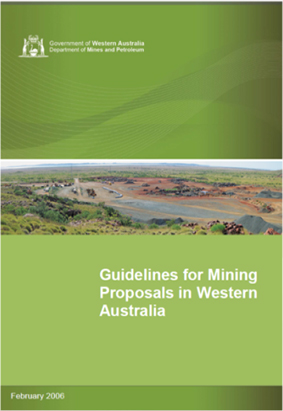
Under the Reforming Environmental Regulation initiative, the Department of Mines and Petroleum (DMP) has incorporated the principles of best practice environmental regulation into its policies, practices and standards. Already under the reform, DMP has revised and updated its Annual Environmental Reporting Guidelines, and (in conjunction with the Environmental Protection Authority) the Mine Closure Plan Guidelines.
The final major review of mining related guidelines is the Guidelines for Mining Proposals.
Since early 2015, DMP has been working on the new draft in consultation with a small Industry Reference Group.
The Industry Reference Group for Mining Proposal Reform has provided its advice on the latest draft of the Guidelines for Mining Proposals in Western Australia (the Guidelines), including the proposed risk assessment framework and key environmental factors to be considered in the Mining Proposal and associated baseline environmental data.
DMP is in the final stages of incorporating the advice into the final draft which will be used for the public and industry consultation period. A stakeholder briefing on the proposed changes will be held after the Guidelines are released for stakeholder comment. DMP aims to have the Guidelines available on the website for consultation and stakeholder comment in September 2015 for a period of eight weeks.
Mining Rehabilitation Fund (MRF) update
The second compulsory reporting year of the Mining Rehabilitation Fund (MRF) has resulted in an impressive 98 per cent of reports lodged before the 30 June deadline. Prospectors were again our high performers with 99.3 per cent of prospecting tenements successfully reporting before the close of the period.
Department of Mines and Petroleum (DMP) Executive Director Environment, Dr Phil Gorey, said the high compliance rate was a credit to tenement holders and the department’s MRF team.
“It’s extremely pleasing that industry has embraced the MRF so strongly with a nearly two per cent higher compliance rate this year than in 2014,” Dr Gorey said.
“The department provided a lot of support for tenement holders and tenement management companies in the months leading up to the reporting deadline.
“The higher rate of compliance this year suggests tenement holders were not only made aware of their reporting obligations but had the support they needed to complete the online report.”
Although the Mining Rehabilitation Fund Act 2012 allows DMP to issue a 30 day levy notice payment period, the department has again given tenement holders 60 days to pay.
Tenement holders who did not submit the MRF report for 2014-15 were issued a $4000 fine early in July. The MRF legislation requires infringement notices to be sent before 21 July each year. The first MRF reporting period closed 30 June 2014 and 1184 notices were issued to holders who failed to report by the close of the period. After the close of the 2015 MRF reporting period ending 30 June 2015 only 152 fines were sent to holders who failed to report. Of the 152 infringement notices issued, 97 fines have since been withdrawn when the holder completed a late report.
“Payments received on levy notices issued this year will result in a further $25 million paid into the fund, which has a current balance of more than $33 million,” Dr Gorey said.
Over $1 billion returned to industry through the retirement of unconditional performance bonds and the successful implementation of the MRF
The first compulsory reporting period for the MRF closed on 30 June 2014. By December, over $1 billion worth of unconditional performance bonds had been retired as tenement holders transitioned into the MRF. This money was previously tied up in environmental bonds but is now back with companies and helping to boost their exploration and mining activities.
Under the old system, DMP held over $1.2 billion in unconditional performance bonds as security to ensure operators met their rehabilitation requirements following mine closure. The MRF has replaced the bond system with an annual levy.
Some tenement holders’ bonds have been retained by the department due to concerns including previous non-compliance with environmental conditions. These tenement holders are still required to pay the annual levy.
Aside from supporting jobs and investment, the MRF encourages companies to progressively rehabilitate sites, as their annual fund contribution will then be reduced. The data from the second MRF reporting period demonstrates that industry is responding to the MRF and progressively rehabilitating disturbances on their tenements.
MRF data shows increase in rehabilitation
As with 2014, DMP has released on its website the reported disturbance and rehabilitation data for all Mining Act 1978 tenements. This is part of DMP’s commitment to providing the most up to date and comprehensive data on mining activity in Australia.
The area of mining and exploration ‘land under rehabilitation’ in Western Australia has increased seven per cent in 2014-15, compared with 2013-14, according to initial analysis of ground disturbance data submitted by mining tenement holders.
This positive trend will reduce the costs to tenement holders and reduce the rehabilitation liability for the State. The MRF is designed to encourage progressive rehabilitation and early rehabilitation is a good environmental outcome.
Ground disturbance data must be reported annually under the MRF, which became compulsory on 1 July 2014 following a year of voluntary participation.
The disturbance data collected through the MRF is important for determining levy payments but also reveals a picture of the mining and exploration footprint in Western Australia under the Mining Act 1978.
Over time, this data will reveal disturbance and rehabilitation trends, improve transparency, and aid in the purchase and transfer of liabilities and assets.
MRF audits
The MRF team undertakes an annual audit program to ensure industry consistently submits accurate data and has a sound understanding of MRF reporting requirements. Audits will be undertaken on a cross-section of 2014-15 MRF reports to ensure the data that has been lodged is accurate and the State is being adequately compensated for the rehabilitation liability on mining tenements.
It is important that industry is aware that all data submitted for the MRF can be audited and it is equally important that DMP has a consistent approach to auditing MRF information.
The MRF team undertook 174 audits for the 2013-14 reporting period. Key findings from the MRF desk top audits included:
- minor discrepancies in the accuracy of areas reported
- errors in distinguishing historical disturbances
- errors and omissions of roads and tracks
- errors or misunderstandings related to the ‘Land under rehabilitation’ category.
Officers from the department will commence auditing 2015 MRF reports from September 2015.
It is vital that tenement holders communicate and respond to the department’s requests for further information or records in a timely manner. The MRF team is available to assist if you have any questions when you receive a request to provide records.
Draft Abandoned mine policy released for public comment
A draft abandoned mines policy was recently released for comment by the department (see the ‘Abandoned Mines Policy’ article in this edition). The consultation period for feedback on the Policy has now closed however the draft policy is available to view via the Abandoned Mines link on the MRF web page:
The rehabilitation and management approach presented in the policy will be trialed across four pilot site projects over the next 18 months to two years.
The pilot sites are:
- Black Diamond Coal Mine
Allanson – Shire of Collie
- Pro-Force Mining Plant
Shire of Coolgardie
- Bulong Nickel Tailings Storage Facility
City of Kalgoorlie-Boulder
- Elverdton Tailings
Shire of Ravensthorpe
Stakeholder consultation planning for the Black Diamond Coal Mine is currently underway, while an auction of the Pro-Force mining plant is planned for October 2015.
Successful completion of these projects will result in direct benefits to the local communities and the environment. The lessons learned will encourage a continuous improvement approach for future mine site rehabilitation and management activities undertaken by the State Government and industry.
MRF 2015 data release
The MRF data will be published on DMP’s website annually. Released data shows ground disturbance as reported by the tenement holder and can be found in the documents section of the MRF web page.
In 2015 there are approximately 19,600 mining tenements across the State and, as a requirement of the MRF, all tenement holders are required to provide DMP with accurate information of the types and areas of ground disturbance for each tenement.
This data demonstrates how much land is actually disturbed in each year by exploration and mining companies on Mining Act tenure. The data builds on the information collected and monitored by DMP when it approves and monitors a project.
The released MRF data is available for users to filter and search by region, type of disturbance and type of lease.
The public will also be able to access the data to gain a detailed picture of mining and exploration activities in their area.
Those accessing the data should note:
- Mine Activity Type descriptions are those as defined in the Mining Rehabilitation Fund Regulations 2012.
- Mine Activity Type "There is no assessment information for this tenement" means that the tenement holder reported that there was no reportable disturbance or land under rehabilitation for that tenement.
- Tenements ceased before 30 June 2015 are not included in the spreadsheet.
DMP undertakes audits each year on the data provided by industry to ensure it provides an accurate representation of the disturbance on tenements. If you have queries regarding the data please email the MRF team at MRFenquiry@dmp.wa.gov.au
MRF survey
In the June edition of the Environment eNews, the MRF team requested tenement holders complete a short survey about the MRF online system, customer service and future system enhancements including combined reporting opportunities.
Key messages in the responses provided by tenement holders and managers were:
- Tenement holders are supportive of combining the MRF and Annual Environmental Report requirements (AER).
- The amount for the infringement notice for failing to report should remain at $4000.
- Most did not see significant value in combining Form 5 reports with the MRF.
The team is reviewing the responses and will consider how to further improve the online reporting system. Feedback can be provided at any time by emailing the team at mrfenquiry@dmp.wa.gov.au
MRF website
The MRF website includes information such as frequently asked questions, a guidance document and step-by-step guide to assist tenement holders with reporting. This, and a lot more information including links to the legislation, is all available on the MRF homepage under the headings ‘Related Links’ and ‘Documents’ in the right hand window pane.
Regulator Workshop for Rehabilitation Success in the Pilbara Project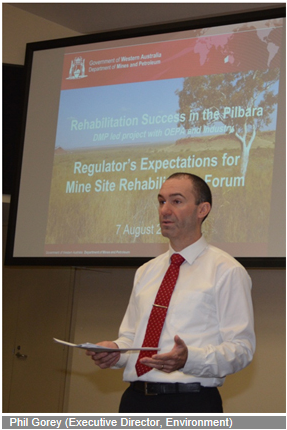
The Department of Mines and Petroleum (DMP) initiated the "Rehabilitation Success in the Pilbara project" in 2014 as a body of further enquiry into the success of rehabilitation activities of mined landscapes in the Pilbara.
The project aims to:
- review the current status of rehabilitation
- examine the efficacy of the regulation of rehabilitation
- improve existing guidance for industry encouraging an adaptive management process through effective monitoring.
A workshop with government and industry representatives was held in March this year to introduce the project. A second workshop was held on 7 August 2015 with DMP representatives and representatives from the Department of Water, the Office of the Environmental Protection Authority, Department of Parks and Wildlife, Department of Environment Regulation and the Department of State Development.
The aim of the workshop was to:
- review and define agency roles and responsibilities
- explore alignment of expectations for rehabilitation outcomes
- share ideas for optimising clarity and consistency of our desired message to industry.
Key findings and points of discussion included:
- Clarifying agency roles and legislative controls for various
aspects of mine rehabilitation and closure.
- Defining regulators’ rehabilitation expectations by examining end land use, biodiversity values, landform design and stability, air, soil and water quality.
- There is a need to better communicate clear definitions on rehabilitation and monitoring timeframes and terms such as ‘safe’ and ‘stable’.
- The collection of adequate baseline data is critical to ensure successful rehabilitation planning and formulation of completion criteria.
- It was agreed that effective engagement between regulators and industry at all stages of mine planning is critical to enhance environmental management of mine sites, particularly if engagement with site managers can be achieved.
- Progressive rehabilitation and closure planning needs to occur throughout the life of the mine and rehabilitation activities need to be scheduled into mine planning. Key issues relating to rehabilitation need to be identified as early as possible, particularly with regard to contamination.
- There were a number of mechanisms discussed to promote consistency across government agencies, e.g. joint site inspections, working agreements/MOUs, joint site closure planning meetings, and annual regulator workshop to name a few.
The next stage of stakeholder engagement for the Rehabilitation Success in the Pilbara project will include a workshop later this year with regulators and industry to discuss the outcomes from both the March and August workshops. In parallel, other project deliverables are advancing with scoping out sub-projects to prepare completion criteria guidelines and a rehabilitation monitoring framework.
For further information, please contact:
Danielle Risbey (08) 9222 3593
Project Manager danielle.risbey@dmp.wa.gov.au
Joint tailings storage guides will streamline application and compliance processes
Following the release of Tailings storage facilities in Western Australia – code of practice, Department of Mines and Petroleum's (DMP) Resources Safety and Environment Divisions have worked together to prepare two guides that complement the code of practice and aim to improve certainty in approvals and compliance.
The two new guides were released in August and are now available on the DMP website.
The tailings storage facilities (TSF) guides were prepared by a working group that included Geotechnical Mines Inspectors and Senior Environmental Officers, and aligns the industry consultation, undertaken when developing the code of practice.
"The guidance material streamlines the application and compliance processes for industry and ensures a consistent approach to the department's regulatory activities," Environment Division Executive Director Dr Phil Gorey said.
"The two divisions have worked closely together in recent years to reduce duplication and minimise the regulatory burden on industry, while ensuring environmental and safety standards remain high."
The Guide to Departmental requirements for the management and closure of tailings storage facilities assists designers and operators prepare the reports required to manage a TSF, while the Guide to the preparation of a design report for tailings storage facilities assists TSF designers prepare the design reports.
DMP environmental guidelines, mining tenement conditions and the tailings storage facility code of practice require these reports to be submitted to the department.
Mines Safety Director Andrew Chaplyn said the need for the guidance material on TSF reports became apparent during development of the code of practice.
"Officers from the Resources Safety and Environment Divisions worked together during 2012 and 2013 to jointly develop the Tailings storage facilities in Western Australia – code of practice, which was released in October 2013," Mr Chaplyn said.
"DMP undertook extensive industry consultation, including two public comment periods, while developing the code of practice."
"During the consultation process it became apparent that guidance material was needed to help industry comply with the reporting requirements, and the two TSF guides were consequently developed through 2013 and early 2014."
The TSF working group consulted with industry geotechnical specialists on the content of the Guide to the preparation of a design report for tailings storage facilities.
"The design report that's required is technically detailed and for that reason specialist industry input was sought," Mr Chaplyn said.
Comments received from seven industry specialists were incorporated into the guides.
Environmental assessment of geotechnical or high risk structures such as TSFs, often result in an increase in "end to end" approval timeframes. To expedite the environmental approval for TSF design reports, the guide also allows Registered Managers and tenement holders to engage independent and technically competent third party reviewers to verify the TSF design report.
As part of DMP's commitment to continually improve safety and environmental management, the design may still be audited before or subsequent to environmental approval, and additional information may be requested by DMP.
Record spike in mining and exploration applications for June/July 2015
The Department of Mines and Petroleum (DMP) received a large spike in mineral applications during June and July based on a three year rolling average:
Mining
- 21 per cent increase in Mining Proposal applications from the Southern Region inspectorates, with 68 new Mining Proposals.
Prospecting and exploration
- 70 per cent increase in Programme of Works with 646 applications received see graph. This total includes a 320 per cent increase in prospecting Programme of Works applications.
DMP is actively working through this record amount and is focused on meeting its KPIs.
Petroleum and Native vegetation areas are experiencing normal application levels.
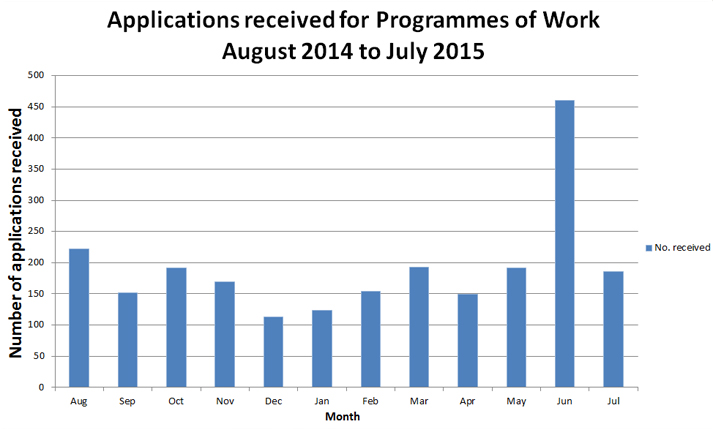
Exercise Westwind
Exercise Westwind was the first Level 3 exercise in the National Plan history with a theoretical loss of well control from an offshore facility in the North West Shelf. This tested industry arrangements to respond to such a scenario.
The exercise was planned and led by the Australian Marine Oil Spill Centre (AMOSC) in conjunction with the Australian Maritime Safety Authority (AMSA), Department of Parks and Wildlife, Department of Transport and combined personnel from the AMOSC core group and the National Response Team. Sixteen oil and gas companies and many other contributors with specialist knowledge or experience in environmental management and oil spill response also participated.
The exercise consisted of two phases including a Perth based strategic response on 27 and 28 May and an operational response co-located in Perth and Exmouth between 8 and 12 June.
The operations phase of the exercise involved operational strategy development through the Incident Management Team (IMT) based in Perth, combined with operation controls and tactical operations in Exmouth. This included source intervention, aerial surveillance, aerial dispersant application and offshore, near-shore, shoreline and oiled wildlife response.
The Department of Mines and Petroleum (DMP) participated in both phases of the response with one officer attending the Perth based strategic response to provide regulatory advice and two officers attending the operational response in Exmouth as trained and experienced members of the National Response Team.
The two DMP officers involved in the operational response undertook multiple functions throughout the exercise period including marine deployment, shoreline deployment and operational control tasks. These officers have gained valuable experience in both the hands-on practicalities and constraints of oil spill response, as well as practical experience and insight into incident management.
Valuable learnings are also being collated from all aspects of this exercise which will improve the knowledge and understanding of petroleum operators and regulators. These learnings, combined with the hands-on practical experience gained by DMP officers, will aid in the continual improvement of regulation of petroleum operations and oil spill contingency planning in Western Australia.
Level 3 Incidents are generally characterised by a degree of complexity that requires the Incident Controller to delegate all incident management functions to focus on strategic leadership and response coordination and may be supported by national and international resources.
The National Response Team is a group of trained and experienced personnel from various National Plan stakeholder agencies that is available to provide support across all response disciplines to any National Plan Combat Agency in the event of a major oil pollution incident. This team is managed by AMSA as part of the Inter-Governmental Agreement on the National Plan to Combat Pollution of the Sea by Oil and other Noxious and Hazardous Substances 2002 of which Western Australia is a signing party.
State Response Team
Western Australia also has a trained and experienced State Response Team which includes DMP Environmental Officers and is managed by the Department of Transport to provide support for WA oil pollution incidents as outlined in the Inter-Governmental Agreement to support the Westplan for Marine Oil Pollution.
The AMOSC Core Group is the petroleum industry supplied personnel who are experienced and well trained in marine spill response operations. This team is managed by AMOSC and has around 120 members from 12 companies ready for response.
Compliance actions
The Environment Division oversees an Environment Enforcement Panel that considers cases of alleged breaches of tenement conditions under the Mining Act 1978 and provides advice to the Minister for Mines and Petroleum on whether forfeiture, or a penalty in lieu of forfeiture, should be imposed. The Department of Mines and Petroleum considers it important to raise industry’s awareness of common types of breaches that occur with an aim of ensuring that ongoing compliance is maintained.
Penalties in lieu of forfeiture imposed by the Minister for Mines and Petroleum
This is a consolidated list of confirmed Mining Act 1978 breach of tenement conditions since March 2015 that have had a penalty imposed by the Minister for Mines and Petroleum. The scale of penalties under the Mining Act 1978 increased on 3 February 2013.
|
Penalty |
Nature of Breach |
Learnings for Industry |
Detection By |
Minister’s Decision Date |
No. of Tenements |
Individual or Company |
|
$9000 |
Altering or expanding operations without approval |
Infrastructure outside of approved area. Ensure all appropriate approvals have been granted prior to undertaking clearing activities and installing infrastructure. |
Self-reported |
24/6/2015
|
1 |
Company |
Approvals Performance Report
April – June 2015
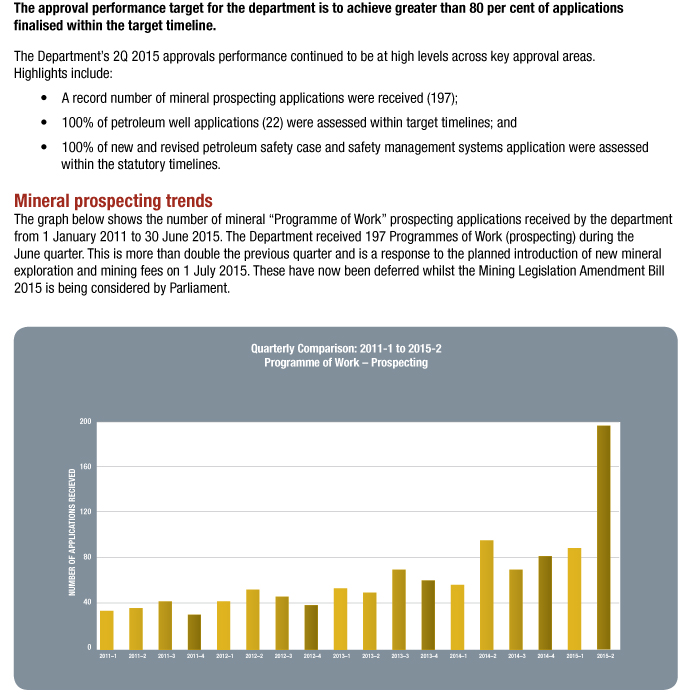
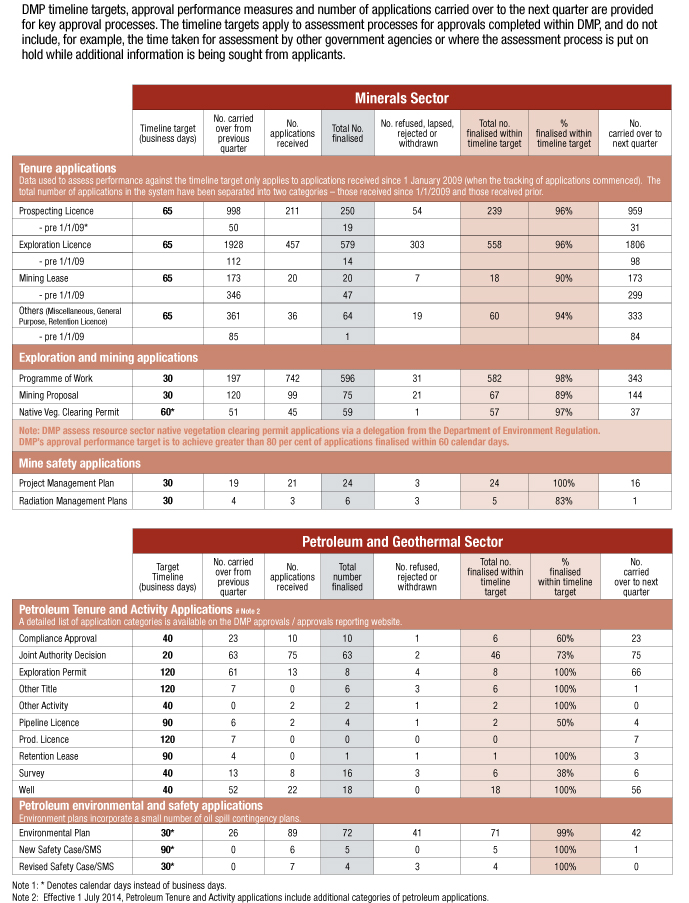
Contact numbers for the Environment Division
Please keep these contact details handy for DMP’s Environment Division.
Minerals assessment or compliance enquiries
The map linked here provides you with the contact details of the DMP Environmental Officers responsible for your inspectorate/mineral field area.
Inspectorate map and responsible Environmental Officers
EARS / EARS 2 online system enquiries
General application and compliance reporting enquiries
Email : EARSManager@dmp.wa.gov.au
Phone : (08) 9222 3535
MRF enquiries
Mining Rehabilitation Fund enquiries
Email : mrfenquiry@dmp.wa.gov.au
Phone : (08) 9222 3162